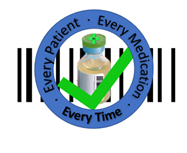
Author: Barry McClain, MS PharmD
Date: 11/19/2022
A publication of pharmacyinformatics.net
Description: This article has specific details on the current state of barcode medication administration (BCMA) and the fact that I believe we have a long way to go in our journey.
It is common to have big goals in healthcare. Noble goals. It is advertised every day. A great example is curing cancer. Eradicate cancer. For the world of pharmacy informatics, here is the true north for BCMA: Every patient, every medication, every time (figure 1). And before jumping into exceptions and more complicated scenarios, just like cancer, there is more than just curing, as there is prevention, detection, treatment, management etc. And there is certainly not just one intervention as well.

For BCMA, the job is not done until technology is fully optimized to:
For every patient, every medication, every time.
That is the proposed barcode medication administration campaign and challenge to healthcare. The rest of the article will provide some perspective on how to get to that ideal state.
One might say, “how could we ever do BCMA in all situations, especially ones where seconds matter?” The better question is how can we optimize technology to transiently, or even ambiently make it a reality? That ultimately means safe medication administration is going to take more tools than just barcode scanning alone, aligning the right tool for the right job, and working smarter and not harder.
But before getting too far, here are some technology fundamentals to cover, including three very basic elements to BCMA, or more broadly, machine-readable medication administration.
This article is going to focus on two types of product (patient) identification
Outside the scope of the article is anything that deals with drug analysis that is seen in drug manufacturing or medication preparation (e.g. gravimetric measurements, Raman spectroscopy, etc.), or any types of biometrics for patient identification.
Advantages of RFID are very noticeable compared to typical optical recognition.4 Hands down, RFID is a more advance way of recognizing medications and patients. It is important to understand the benefits:
The one major con is cost (and privacy depending on use case), which is unfortunate since the advantages are very clear.
There are other things machines can do using sophisticated cameras and software. This is an opportunity for healthcare and vendors to look at what other industries are doing and continue to push for these advances. Be clever with engineering!
Here are some examples of out of the box thinking about how we can look beyond just product identification using this technology.
inspecting the integrity of a drug (figure 2), or the amount we are drawing up by gauging (figure 3).
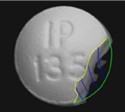
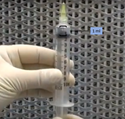
Now going into the data, the Leapfrog Hospital Survey: Barcode Code Medication Administration, 2018 Report5 provides a snapshot of the state of BCMA in the hospital setting. Leapfrog has standards for the surveys that they do, and for BCMA, there are four criteria hospitals need to meet.
The first item is having BCMA implemented in inpatient units. Leapfrog requires medical units, surgical units, labor and delivery, and intensive care units all use BCMA.
The next part is ensuring where barcoding is deployed, at least 95% of both patient and medications are scanned.
Leapfrog also has some other best practices. One of these items is ensuring that all seven decision support elements that they have identified are included into the technology. That includes vital signs, allergies, second nurse checking when needed, wrong time, wrong dose, wrong patient, and wrong medication.
And then they have five other best practices or processes to help prevent workarounds and govern the use of BCMA:
That is the Leapfrog hospital BCMA standard.
The results are not optimal when looking at the details. One area where hospitals are falling short is the fact that nearly 42% are failing to scan both the patient and medication for at least 95% of bedside medication administrations. That is pretty concerning in all due respect. Another area where there is a deficiency is the adoption of the more advanced clinical decision support elements (figure 4). Clearly there is a lot more work to do for hospitals across the country.
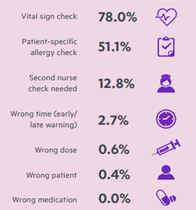
When thinking about Leapfrog, one should think about pushing the boundaries. Based on the current standards, there is certainly room for improvement. The Leapfrog survey does a great job pushing innovation in a “vertical” direction with the adoption and stretch goals of using decision support and maximizing the software’s capability of identifying things other than just the wrong drug. The threshold of a minimum 95% capture of both patient and medication gives the survey standards extra height too. Where the survey needs a lot more work comes down to the “horizontal” jump. Having a standard that is exclusively looking at inpatient units is extremely bare minimum. That is not much of a stretch goal and there really needs to be a push towards including more (all) areas that administer medications. Thus, increasing the length of the jump.
The point here questions why these other areas are commonly missing from BCMA metrics, as these are places that are very prominently giving medications.
However, there is more to medication administration than hospitals. Leapfrog only focuses on hospitals., although they do have measures on ambulatory surgery centers, but those have no mention of BCMA at all. But even going beyond what Leapfrog is measuring, it is very uncommon to see metrics or work to implement BCMA around ambulatory areas published.
What number of safety issues are not being prevented and/or caught without any BCMA in these areas?
A great example of the use of BCMA in the ambulatory clinics is the presentation “Implementing Bar Code Medication Administration in the Ambulatory Realms”, which was presented in 2021 at the Summer Institute in Nursing Informatics.6 One of the motivations of this implementation was, “Following a patient harm event, Vanderbilt University Medical Center (VUMC) vowed to implement BCMA in all ambulatory and procedural areas.” That kind of declaration is pretty much what this article is campaigning for “every patient, every medication, every time”. Very commendable.
What did VUMC learn? In a nutshell, they learned what most successful implementations look like. That it was worth doing.
Here are the qualitative results they presented:
What did they learn from a quantitative perspective (figure 5)?
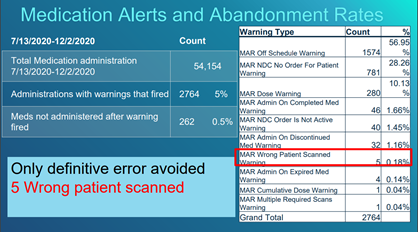
The presenters pointed out five definitive errors all related to wrong patient being scanned. Note, in this particular implementation of BCMA in the clinics, they are printing and scanning patient wristbands in addition to medications. A wrong patient warning is certainly a definitive problem to detect. It would appear the expired medication warning is also a definitive error as well. Just knowing that most drugs that have 2D barcodes in a clinic setting are likely vaccines, it would seem very significant to catch that type of error too. There are certainly opportunities likely with configuring the electronic health record (EHR) (e.g. medication administration record (MAR) off schedule warning) and training/experience with BCMA to reduce unnecessary warnings. But overall, these results support if a BCMA program is implemented the right way, it is viewed positive and can be successful.
At the same time, someone could look at these data and easily point out a lot of energy is going into a low yield of protection. The counterpoint is very simple. Integrated EHRs are extremely expensive, with health systems sometimes reporting spending well over 100 million dollars in costs.7 That is getting to a cost of a commercial aircraft, which is a good comparator from a safety standpoint. Just imagine an airliner where half the seats don’t have seat belts! That would seem crazy from an aviation safety perspective. A low yield of error prevention is not a good excuse for prohibiting BCMA assuming it is implemented correctly (optimized to increase safety, efficiency, and documentation). The benefit is tremendous when any significant issue can be prevented.
So how can “every patient, every medication, every time” feasibly happen? Being a leader in barcode medication administration requires change. Here are some considerations:
Despite all the advances in healthcare now and into the future, if the simplest part of a process cannot be done safely, then we can only expect to be disappointed. The bigger the advances, the more disappointment when something so simple does not happen appropriately. Thus,
Every patient, every medication, every time.